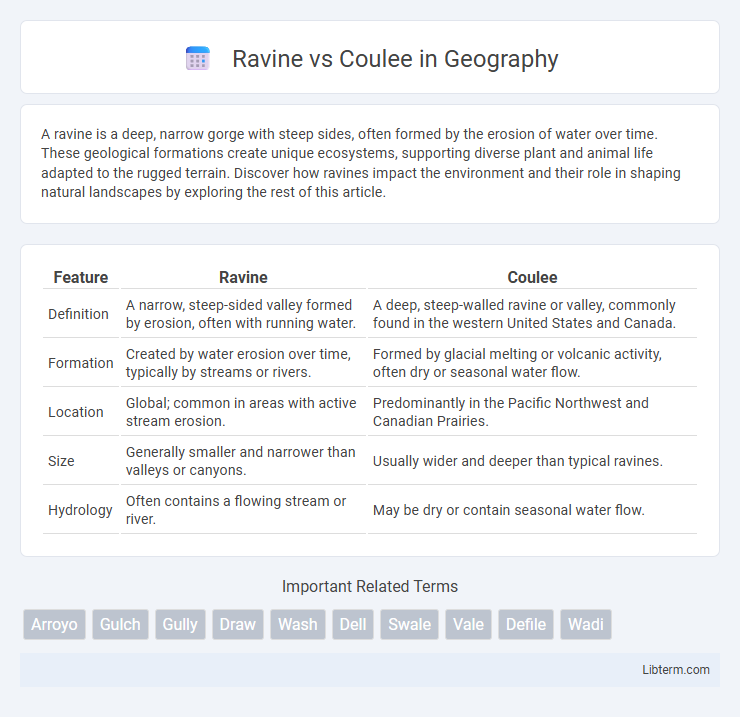A ravine is a deep, narrow gorge with steep sides, often formed by the erosion of water over time. These geological formations create unique ecosystems, supporting diverse plant and animal life adapted to the rugged terrain. Discover how ravines impact the environment and their role in shaping natural landscapes by exploring the rest of this article.
Table of Comparison
| Feature | Ravine | Coulee |
|---|---|---|
| Definition | A narrow, steep-sided valley formed by erosion, often with running water. | A deep, steep-walled ravine or valley, commonly found in the western United States and Canada. |
| Formation | Created by water erosion over time, typically by streams or rivers. | Formed by glacial melting or volcanic activity, often dry or seasonal water flow. |
| Location | Global; common in areas with active stream erosion. | Predominantly in the Pacific Northwest and Canadian Prairies. |
| Size | Generally smaller and narrower than valleys or canyons. | Usually wider and deeper than typical ravines. |
| Hydrology | Often contains a flowing stream or river. | May be dry or contain seasonal water flow. |
Understanding Ravines and Coulees
Ravines and coulees are both types of steep, narrow landforms created by erosion, but ravines typically result from water runoff carving into soil or rock, often found in forested or hilly regions. Coulees are more common in arid or semi-arid areas and may form through glacial activity or volcanic processes, characterized by broader, sometimes dry channels. Understanding these differences helps in land management and geological studies by highlighting distinct erosion patterns and environmental conditions.
Key Differences Between Ravines and Coulees
Ravines are narrow, steep-sided valleys formed primarily through water erosion, often smaller and more V-shaped compared to coulees. Coulees are broader, deeper channels, typically created by glacial meltwater or volcanic activity, featuring U-shaped profiles and sometimes dry or seasonal streams. The key differences lie in their size, shape, and geological formation processes, with ravines being smaller and sharply incised, whereas coulees exhibit larger, more gradual slopes and distinct origins.
Formation Processes of Ravines
Ravines form primarily through the intensive erosion caused by fast-moving water, which carves narrow, steep-sided valleys in softer soil or rock over time. Unlike coulees, which often result from catastrophic flood events or volcanic activity, ravines develop gradually as runoff concentrates and deepens channels, especially in regions with heavy rainfall or melting snow. The continuous process of weathering and soil displacement shapes ravines into distinct landforms distinguished by their size and formation dynamics.
How Coulees Are Created
Coulees are geological formations created primarily through processes of erosion caused by glacial meltwater or volcanic activity, which carve out deep, steep-sided valleys. Unlike ravines, which form from general water runoff and soil erosion, coulees often result from sudden, high-volume water flow shaping the landscape dramatically over short periods. These channels may also be linked to ancient flood events or lava flows that solidified, distinguishing coulees by their unique, abrupt formation history and geological context.
Geographical Distribution of Ravines and Coulees
Ravines predominantly appear in regions with glacial and fluvial activity such as the Midwest and Northeastern United States, characterized by steep-sided, narrow valleys carved by water erosion. Coulees are commonly found in the Pacific Northwest and parts of Canada, often formed by ancient floodwaters or volcanic activity, resulting in broader, shallower valleys. The geographical distribution of these landforms reflects differences in geological history and hydrological processes specific to their locations.
Ecological Importance of Ravines
Ravines serve as critical ecological corridors that support diverse plant and animal species by providing unique microhabitats and moisture retention in otherwise dry landscapes. Their steep slopes and rich soil layers promote nutrient cycling and prevent soil erosion, influencing local watershed health. Unlike coulees, which are often dry or seasonal watercourses, ravines maintain more consistent moisture levels, making them vital for sustaining biodiversity and ecosystem stability.
Unique Features of Coulees
Coulees are distinct landforms characterized by their steep sides and broad, flat bottoms, often formed by ancient glacial floods or volcanic activity. Unlike ravines, which typically have narrower and more V-shaped valleys created by gradual water erosion, coulees can support unique ecosystems due to their size and soil composition. These geographical features commonly appear in regions like the Pacific Northwest and are notable for their dramatic cliffs and layered sediment deposits.
Ravines vs Coulees: Visual Identification
Ravines are narrow, steep-sided valleys often formed by water erosion, characterized by their V-shaped cross-sections and usually wooded or vegetated slopes. Coulees, on the other hand, are broader, more open valleys or channels, typically glacially formed or created by sudden floods, featuring wider, U-shaped profiles with less steep sides. Visual identification depends on the shape and scale: ravines appear as sharp, deep cuts in the landscape, while coulees display wider, flatter bottoms with gentler inclines.
Human Impact on Ravines and Coulees
Human activities such as agriculture, urban development, and deforestation significantly accelerate erosion and sedimentation in ravines and coulees, altering their natural water flow and increasing flood risks. In ravines, intensive land use can lead to habitat loss and reduced water quality, while in coulees, unstable slopes and disturbed vegetation exacerbate soil degradation and runoff. Effective land management and restoration practices are critical to mitigating these impacts and preserving the ecological functions of both ravines and coulees.
Conservation and Preservation Efforts
Ravines and coulees require targeted conservation strategies to prevent soil erosion and preserve native vegetation. Riparian buffer zones and controlled reforestation play critical roles in stabilizing these landforms while maintaining biodiversity and water quality. Implementing sustainable land management practices helps mitigate human impact and supports the long-term ecological integrity of ravines and coulees.
Ravine Infographic

 libterm.com
libterm.com